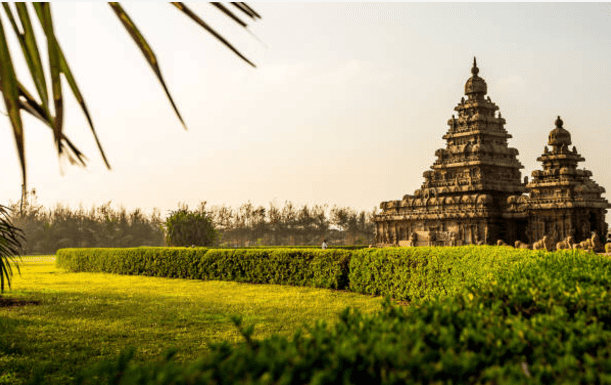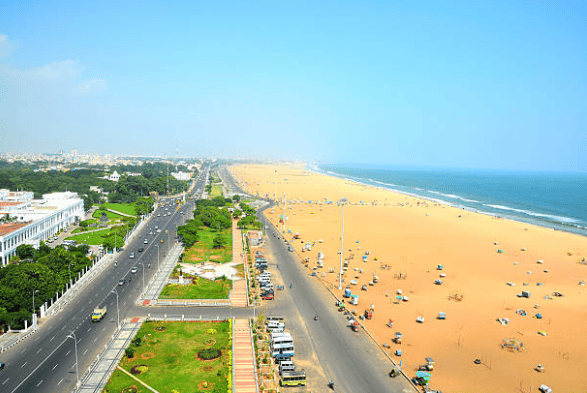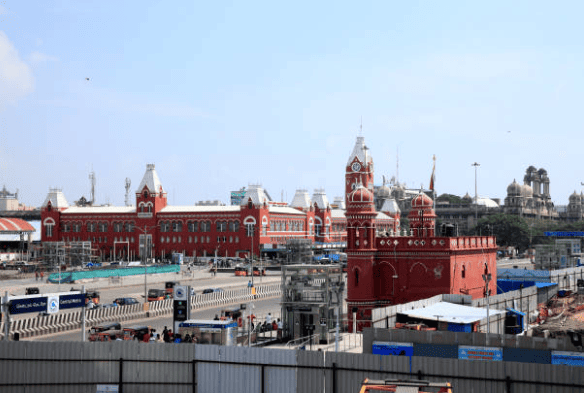Chennai is not a favorite tourist destination for Indonesians. This is evident as you rarely hear people talking about this city in southern India. Perhaps it’s because Chennai isn’t as popular as New Delhi, Agra, Jaipur, Kashmir, or Mumbai. Yet, the city—formerly known as Madras—has plenty of attractions to offer. In fact, many Western travelers frequently visit Chennai.

Despite its lack of popularity, I didn’t let that stop me from exploring the city, especially when I found a round-trip ticket from Singapore to Chennai for just IDR 1.2 million. That was cheaper than a flight back to my hometown, even though Chennai is much farther away.
I quickly bought the ticket and arranged my leave from work. After three months of stressful work in Jakarta, I was ready for a vacation. I managed everything myself, from booking tickets and applying for an Indian visa to reserving a hostel. Thankfully, everything could be done online, including the Indian visa application.
In mid-January, I departed from Singapore to Chennai. It was a night flight, and I arrived in the early hours of the morning. Arriving at midnight posed a challenge since affordable public transport was no longer available. As a backpacker accustomed to budget travel, I aimed to keep costs as low as possible.
The options were limited to airport taxis or ride-hailing services. I had initially requested a pickup service from the hostel I booked, but unfortunately, they didn’t fulfill it. Stepping out of the arrivals hall, I was surprised to see a bustling crowd—even at midnight! Most were taxi drivers waiting to pick up passengers.
I purchased a prepaid taxi ticket at the counter near the exit. The fare to my destination was 350 Rupees, as it wasn’t located in the city center, but about 3 kilometers from Chennai International Airport. The city center itself was several kilometers further away. The atmosphere felt eerie, with cows roaming the streets in the middle of the night.
The hostel I booked turned out to be near a market and looked rather rundown. Exhausted, I went straight to bed. The next morning, I decided to head to the city center. I waited an hour for a bus, but they were all packed to the brim, with passengers almost spilling out. I wondered if this was due to India’s massive population.
It turned out that bus drivers were on strike that day, so there were fewer buses running. A police officer I spoke to suggested taking the train instead. Traveling by train in India was quite the adventure! The trains were old, seating was limited, and the sheer number of passengers made it feel like a swarm of ants.
I spent the day observing life in the heart of Chennai. The city offered a blend of tradition and modernity, earning its title as the cultural hub of South India and the “Detroit of India.” That evening, I dined at a restaurant near my hostel in the Triplicane area.
I ordered chicken biryani, and when it arrived, I was shocked by the enormous portion—enough for two people! However, the locals at the next table managed to finish an entire serving on their own. I, on the other hand, was already full halfway through. Thankfully, finding halal food in Chennai was easy due to its significant Muslim population, including the restaurant I visited.
After dinner, I returned to the hostel. The area was lively but dimly lit, with few streetlights. Many vehicles were parked on the streets, creating a chaotic scene. Despite being India’s fourth-largest metropolitan area, Chennai has its fair share of overcrowded and rundown neighborhoods.
Although the city has a somewhat disorganized appearance, it didn’t deter me from exploring. Many tourist spots were within walking distance of my accommodation. That night, I researched nearby attractions to visit the following day before finally getting some sleep.
The Longest Beach in the World

I started exploring Chennai a bit late. My friend, who had invited me to go out, picked me up at 10:30 AM local time. Our first destination was the Sri Parthasarathy Temple, which was conveniently close to my accommodation. We decided to walk there. That day, there was a celebration ahead of the Pongal Festival, and I was very excited.
Sri Parthasarathy Temple is an ancient and beautiful temple, although its exterior looks somewhat worn. Dating back to the 8th century, this is a Vishnu temple, with statues of Sri Krishna as its iconic feature. Its sturdy pillars appear to be carved from solid stone.
The celebration included various rituals and prayers. Locals prayed from the temple’s entrance all the way to its innermost sanctum. Since I was with my Indian friend, I could join them deeper into the temple. At the end of the ritual, we were given turmeric water and mint leaves.
After visiting the temple, we returned to the hostel for lunch at a nearby restaurant. I asked for a dish with a smaller portion, and my friend recommended something similar to a pancake served with curry sauce. The flavor was quite unfamiliar to me—the spices were very strong. After lunch, we parted ways as my friend had to head to work.
I went back to the hostel to rest and escape the scorching heat of the sun. In the evening, I strolled to Marina Beach, which was within walking distance from the hostel. This beach is a popular tourist spot, bustling with visitors. What stood out was the sight of women wearing saris enjoying the beach.
I was stunned by the sheer size of this beach. Its width from the main road to the shoreline is about 500 meters, and it stretches a staggering 13 kilometers in length. It resembles a desert, which explains why Marina Beach is regarded as the second-longest urban beach in the world. However, swimming isn’t recommended due to the high and strong waves.
Most visitors, primarily locals, sat on the sand or stood mesmerized by the rhythmic waves. Others were horseback riding, playing volleyball, or flying kites. The beach was also lively with children’s games and their joyful laughter. For a quieter experience, you can head to the southern end near the Chennai Marina Lighthouse.
For a panoramic view, you can climb the lighthouse. There’s an entrance fee: 20 Rupees for locals and 50 Rupees for foreigners, with an additional 25 Rupees if you bring a camera. The lighthouse is over 45 meters tall and has 10 floors. At the top, you’ll enjoy a 360-degree view of Chennai.
Along the beach, there’s a promenade and small gardens adorned with statues of Indian heroes and prominent figures, including Mahatma Gandhi. Walking from one end of the beach to the other would be exhausting—I could barely manage two kilometers before giving up.
I decided to take a bus instead. It cost only 4 Rupees—a bargain! Traveling from the southern to the northern end of the beach took less than ten minutes. I got off in front of the University of Madras, right across from the MGR Memorial, located on Marina Beach.
Make sure to visit this memorial before or after enjoying the beauty of Marina Beach. The MGR Memorial honors former Chief Minister M.G. Ramachandran. The place is beautiful and well-maintained, with a museum to explore. Unfortunately, the sky was overcast that evening, so the photos I took didn’t turn out well.
Next to the MGR Memorial is the Anna Memorial, another remarkable site. Named after Anna, a prominent Tamil leader and statesman, this place honors his significant contributions to Tamil Nadu. Many locals visit to pray and perform rituals. These memorials seem to serve as resting places for former ministers and other dignitaries.
Exploring Chennai

The next day, I returned to Marina Beach, the MGR Memorial, and the Anna Memorial to take photos. The sky was a clear blue, which energized me and made for great shots. Once I had captured everything, I continued exploring the city. From Marina Beach, I walked to the Victory War Memorial. There wasn’t much to see there, so I kept walking until I reached Fort St. George, the first British fort in India, built in 1644.
The fort wasn’t very large or tall—nothing particularly imposing. I decided to just view it from the outside, as the sight of soldiers standing guard at the entrance made me a bit uneasy. Turning back, I headed again toward the Victory War Memorial. Along the way, I witnessed several surprising and unique scenes.
At one point, I saw people lined up in front of some bushes, which piqued my curiosity. It turned out they were relieving themselves! I could only smile at this peculiar habit. Elsewhere, I saw a homeless man sleeping on the sidewalk wrapped in a sarong, despite the scorching heat. Such sights were quite common.
This mix of contrasts—a metropolitan city with sprawling slums and colonial-style buildings—seemed to define Chennai. The old colonial structures were particularly eye-catching, painted in distinctive hues of brick red and white. As I crossed a bridge over a river with black-colored water, I stumbled upon Chennai’s zero-kilometer marker. It was just a milestone, but spotting it made me unexpectedly happy.
Not far from there—about a kilometer away—I arrived at Chennai Central, the city’s main transportation hub for trains and buses. Entering this terminal requires caution, as ticket inspectors are everywhere. I was mistaken for someone who had just arrived by train, and an officer demanded to see my ticket.
After a brief argument, I quickly left the terminal. From Chennai Central, I made my way to a market. Behind it lies the Chennai Moore Market Complex, which wasn’t much different from traditional markets in Indonesia. It was here that I bought souvenirs for my friends.
